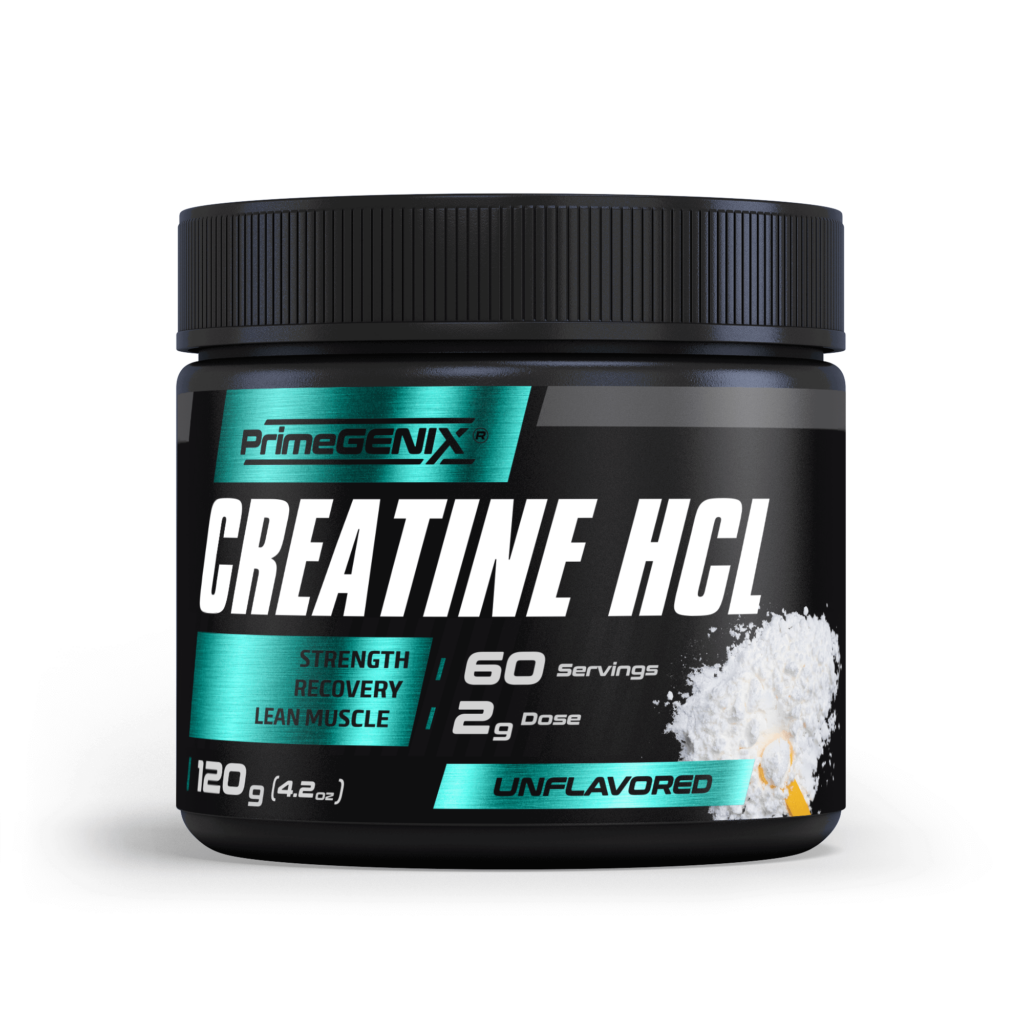Creatine supplements promise enhanced performance and muscle gains. While they are a staple in many gym enthusiasts’ arsenals, selecting the right form can seem daunting for beginners. Among the numerous options, two stand out as prominent choices: Creatine HCL and Creatine Monohydrate.
Creatine is a naturally occurring compound in the body that supports energy production during high-intensity activities like sprinting, high-intensity interval training, and weightlifting. As the most widely used forms of creatine, Creatine HCL and Creatine Monohydrate have gained popularity among gym-goers seeking to optimize their workout performance and results.
Understanding the nuances of creatine supplementation is crucial for determining which form to use. This article compares the benefits and drawbacks of these two forms to decide which one reigns supreme for maximizing gym performance and muscle growth.
By the end of this comprehensive analysis, which includes practical considerations and common misconceptions surrounding these two forms, you’ll have a clear understanding of which supplement form is better suited to your fitness goals.
Keep reading to uncover the truth and dispel the myths behind Creatine HCL and Creatine Monohydrate to make an informed decision to support your fitness journey.
What Are Creatine Supplements?
A solid grasp of creatine and creatine supplements is essential for those dedicated to maximizing their gym gains. Creatine is a naturally occurring compound primarily stored in muscles and, to a lesser extent, in the brain and other tissues.
Its primary function is facilitating the production of adenosine triphosphate (ATP), the primary energy currency of cells, especially during short bursts of intense physical activity.
Bodybuilders, athletes, and fitness enthusiasts are the most common users of creatine supplements. They are widely recognized for their efficacy in increasing muscle mass, improving strength, facilitating muscle recovery, and enhancing athletic performance, making them essential for those striving to reach their peak physical potential.
Creatine supplements come in various forms, such as powder or pill. Each offers distinct advantages and potential drawbacks and can be consumed as part of a pre- or post-workout routine. However, emerging research suggests more significant benefits when consumed after exercise compared to pre-exercise1.
Different Forms, Different Benefits
When choosing among the available supplement forms and brands, consider bioavailability, solubility, personal tolerance, and personal preferences. Bioavailability refers to the extent to which a substance is absorbed and utilized by the body. This metric is crucial in determining the effectiveness of creatine supplements.
Solubility, particle size, and formulation influence creatine supplements’ bioavailability and absorption rates. Opting for a supplement form with higher solubility and bioavailability contributes to optimal results.
Higher bioavailability means a larger portion of the ingested dose that enters circulation reaches the muscles for utilization, translating to more significant benefits.
Common Misconceptions About Creatine Supplements
Myths and misconceptions abound in fitness and supplementation. With so much information available, it can be challenging to separate fact from fiction. We’ve got you covered.
This section highlights the importance of making choices based on scientific evidence rather than anecdotal claims.
Let’s debunk the top four common misunderstandings about creatine supplements.
Myth #1 – Creatine is Only for Bulking Up
While creatine effectively increases strength and promotes muscle growth, its benefits extend beyond bulking. Supplementation isn’t just for bulking phases or only for those seeking to gain mass.
Creatine supplementation enhances performance during cutting phases by preserving muscle mass, maintaining strength while in a calorie deficit, and aiding in recovery. It can be a valuable addition to your regimen, whether bulking, cutting, or maintaining.
Myth #2 – Creatine Damages the Kidneys and Liver
Creatine is naturally synthesized in the body and consumed regularly through dietary sources like meat and fish. When taken as directed, creatine supplementation poses little to no risk to kidney and liver function in healthy individuals.
Numerous studies have investigated and debunked this persistent belief, demonstrating that creatine is safe and well-tolerated when used within recommended dosage guidelines2,3,4.
Myth #3 – Creatine Causes Bloating and Water Retention
While creatine supplementation can increase water retention within muscle cells, this effect isn’t necessarily a drawback. Distinguishing between intracellular and subcutaneous water retention is essential.
Intracellular water retention enhances muscle fullness and strength, benefiting muscle hydration and overall performance during training sessions. Conversely, subcutaneous water retention causes bloating and puffiness. Proper hydration and dosage management help minimize potential bloating associated with creatine supplementation.
Myth #4 – Creatine Must Be Cycled to Be Effective
There is no significant evidence to support the necessity of cycling creatine. Research indicates that consistent supplementation with creatine at specific dosages over time yields optimal performance and muscle gains, depending on individual fitness goals5.
While many believe creatine supplementation must be cycled on and off to maintain its effectiveness, there is no scientific proof that cycling or taking breaks from supplementation is necessary.
The following sections explore the benefits and drawbacks of Creatine HCL and Creatine Monohydrate, helping you make informed decisions based on your fitness goals and preferences.

The Advanced Choice: Creatine HCL
Creatine Hydrochloride (HCL) is the go-to option for those striving for peak performance. Guys can expect quicker and more noticeable improvements in strength and muscle growth.
Let’s examine why Creatine HCL stands out as a top supplement choice.
Solubility and Stability
Creatine HCL boasts superior solubility compared to other creatine forms. It mixes effortlessly with water, allowing for rapid muscle absorption and utilization. Say goodbye to gritty, clumpy shakes and hello to smooth, easily digestible doses of muscle-fueling goodness.
Bioavailability
Creatine HCL has a higher bioavailability, ensuring that what you ingest is what your muscles receive. Its high solubility increases its efficiency, guaranteeing maximum absorption. With Creatine HCL, your muscles can soak up every ounce of creatine for explosive energy and strength gains during your most challenging workouts.
Dosage Requirements
Thanks to superior absorption and bioavailability, less is more with Creatine HCL. Compared to other forms of creatine, you can achieve optimal results with smaller doses. There is no need for mega-dosing or loading phases. A little Creatine HCL goes a long way in powering your performance.
Side Effects
Creatine HCL is well-known for its gentle nature on the stomach. While other forms may leave you feeling bloated or uncomfortable after chugging down your creatine, Creatine HCL minimizes the risk of gastrointestinal distress so you can experience smooth sailing in and out of the gym.
The Traditional Option: Creatine Monohydrate
Creatine Monohydrate is a popular choice among athletes and lifters worldwide. Its affordability and proven track record cement its place as the go-to option for those seeking to maximize muscle gains and performance.
Let’s examine what makes Creatine Monohydrate the time-tested supplement choice.
Solubility and Absorption
Creatine Monohydrate offers undeniable benefits, backed by extensive research supporting its effectiveness. One of the primary drawbacks is its relatively poor solubility, which can result in inconsistent absorption rates and clumpy mixtures. Its lower solubility can lead to variability in effectiveness and slower absorption rates, delaying benefits.
Bioavailability
While effective, Creatine Monohydrate’s lower solubility hinders its bioavailability compared to other forms of creatine. Despite a wealth of scientific evidence supporting its effectiveness in enhancing athletic performance and muscle growth, its bioavailability limitations have prompted the development of newer, more soluble forms of creatine to address these concerns.
Dosage Requirements
Due to its lower solubility and absorption rates, Creatine Monohydrate typically requires higher dosage levels to achieve desired results than more soluble forms of creatine. This may necessitate larger serving sizes to produce the same results as other creatine supplements, potentially increasing cost over time.
Side Effects
As a result of consuming larger doses, some users may experience bloating and gastrointestinal discomfort, particularly during loading phases. While these side effects are generally mild and temporary and don’t impact all users, they can be a nuisance for those with digestive issues. Proper dosage management is vital for experiencing optimal results with minimal adverse effects.

Creatine HCL vs. Creatine Monohydrate
The choice between Creatine HCL and Creatine Monohydrate boils down to factors like solubility and absorption (bioavailability), effectiveness and performance, cost, adverse effects, and personal preference.
Let’s see how they compare:
- Solubility and Absorption: Creatine HCL offers superior solubility and absorption rates, allowing for smaller doses, a faster uptake by muscles, and a reduced risk of digestive issues.
- Effectiveness and Performance: Both forms enhance strength, power output, and muscle growth, but Creatine HCL may offer slightly quicker results.
- Cost-Benefit: Creatine Monohydrate often necessitates larger serving sizes, potentially leading to increased costs over time
- Adverse Effects: Creatine Monohydrate’s larger dosage requirements can contribute to gastrointestinal issues.
- Personal Preference: Individual goals and tolerance levels are essential when selecting the most suitable creatine form for your fitness regimen.
Ultimately, both Creatine HCL and Creatine Monohydrate are backed by a wealth of scientific evidence supporting their safety and efficacy in enhancing performance and muscle growth, increasing lean muscle mass, and facilitating muscle recovery.
Choosing the proper creatine form for supplementation can make all the difference in your fitness success. While Creatine Monohydrate remains a viable option for seasoned gym veterans seeking a supplement with a well-established track record, gym warriors seeking an edge in their training choose Creatine HCL for its unparalleled solubility, absorption, and effectiveness.
Level up your workouts and unleash your full athletic potential with PrimeGENIX Creatine HCL.
Endnotes
1. https://www.ncbi.nlm.nih.gov/pmc/articles/PMC8401986/
2. https://pubmed.ncbi.nlm.nih.gov/31375416/
3. https://www.ncbi.nlm.nih.gov/pmc/articles/PMC9922125

